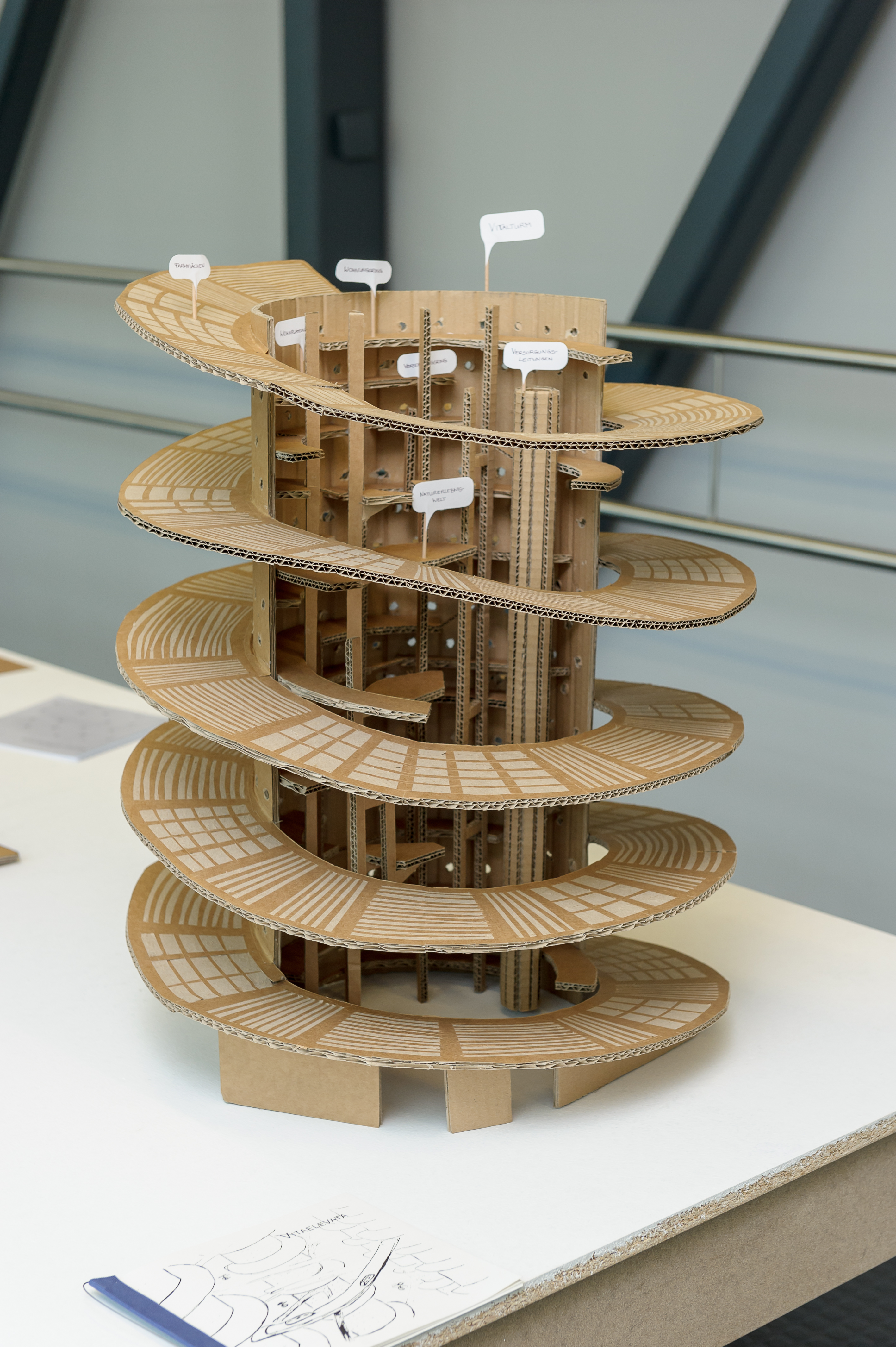Exhibition: Architecture of Utopia

Every architectural design contains a utopian aspect, in which it depicts the ideal model of a social-spatial form as yet not in existence. The utopian dimension of design has, however, been increasingly neglected since the 1970s. In view of the global environmental and economic crises, a new demand has now arisen for utopian visions of alternative lifestyles: the imaginative potential of architecture is highly sought after in this process. The exhibition gathers independent designs of modern architectural, utopian thinking, finding the right setting for this in the biomorphic Kunsthaus Graz.
The projects were designed as part of the master design studio "Architecture of Utopia" held in the summer semester 2014 which was co-taught together with Ana Jeinić and Michael Hieslmaier (model making workshop). The design task involved to imagine an utopian scenario in the form of a text which was translated into a 3D-model. The translation between text and model allowed the tension inherent in utopian thinking between abstract ideals and concrete architectural ideas of a different togetherness to become visible. The results were made accessible to a broad public in the form of 3D models and accompanying texts in an exhibition at the Kunsthaus Graz.
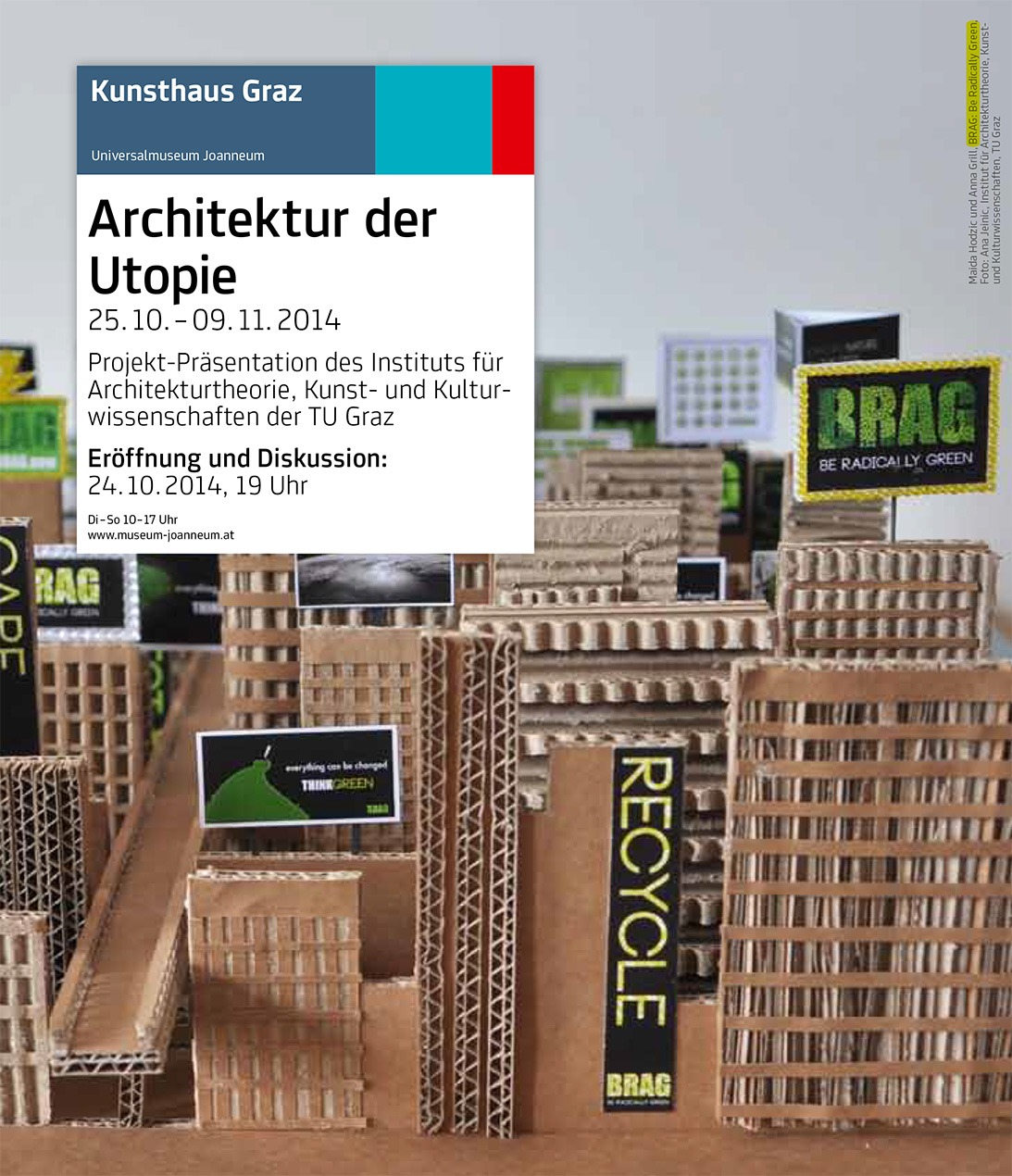
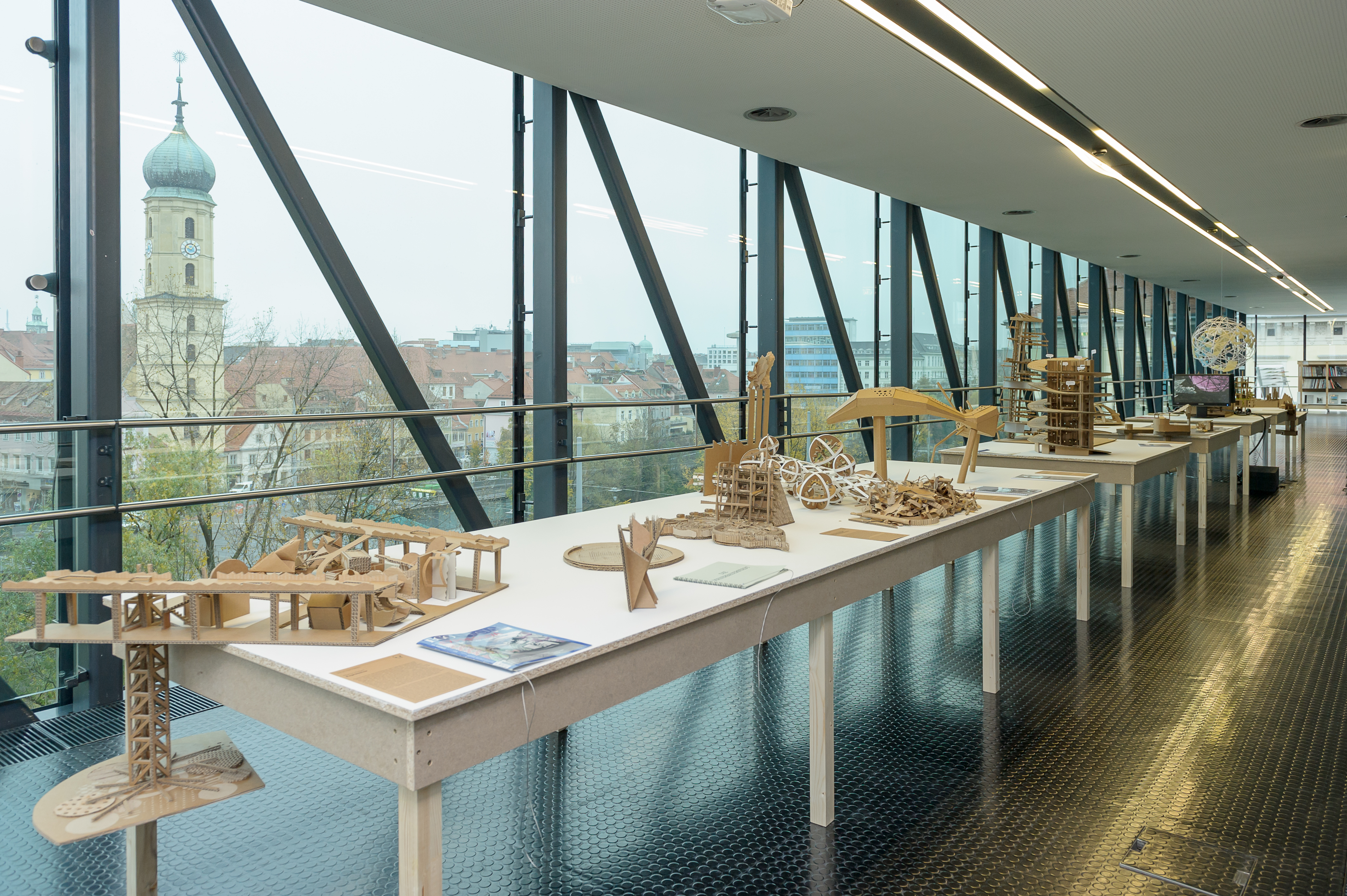
Alexandru Dan: E+ CITY
It is in 2022 when Mr. Buha, an architect living in Antarctica, comes up with the idea of the 100% self-sufficient city taking on the form of a sphere constantly moving. It produces more food and energy than is needed, while at the same time offering excellent living comfort. One of the most innovative aspects of E+ City is the achievement of zero energy transportation. The city counts 2.460 buildings that are connected by transportation tracks. Due to the fact that the city is constantly in rotation at the speed of 0,5m/minute, the citizens can glide from one unit to another using the natural forces of gravity.
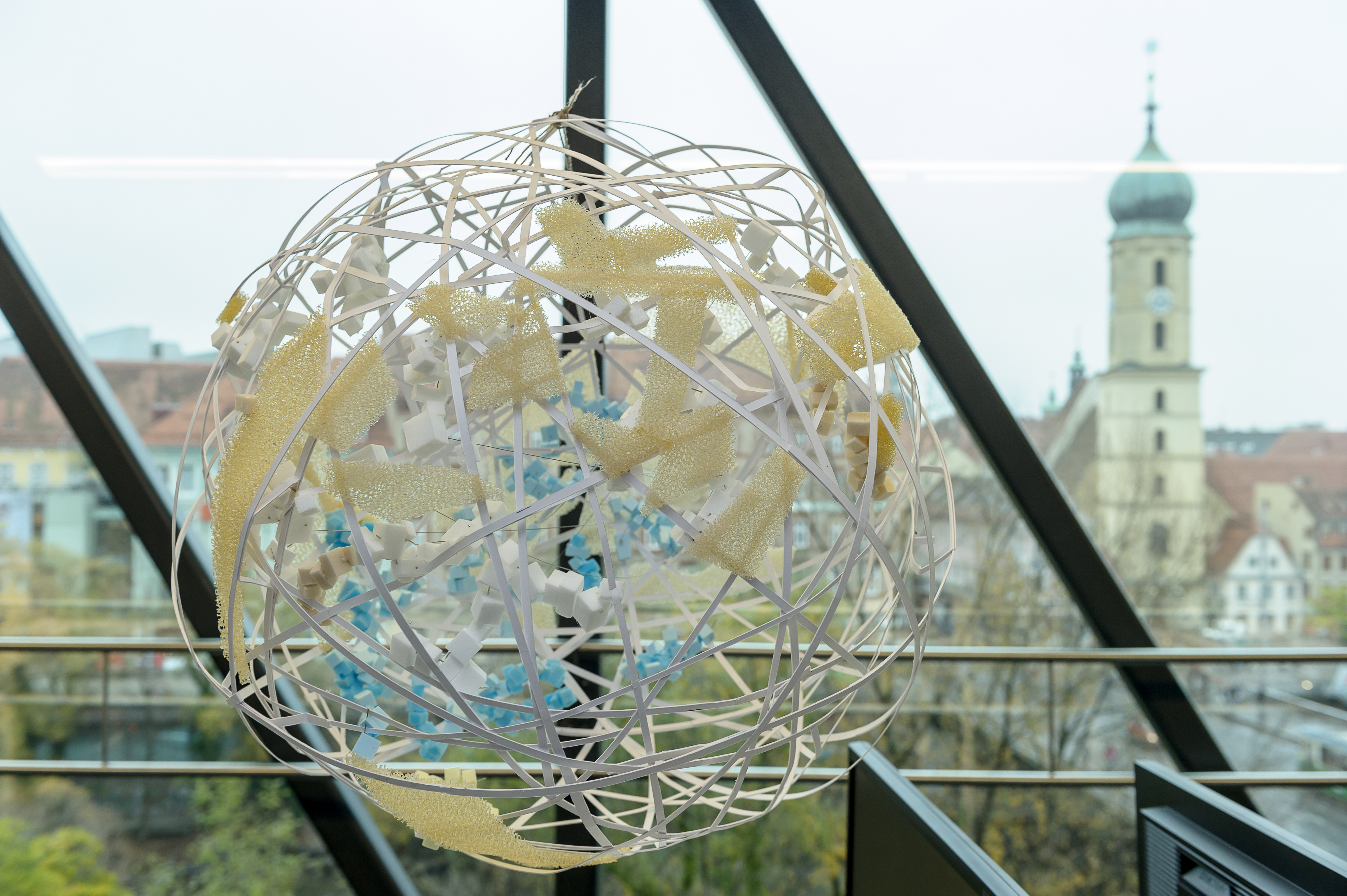
Ching Kwong Wu: Trench City
The demilitarized zone (DMZ) is located at the 38th parallel and is the buffer zone between South and North Korea. The zone's width is 4 km, its length is 250 km. North and South Korean armies are not allowed to enter this zone in order to avoid military conflicts. To ensure peace in this zone, Trench City is managed and monitored by The Neutral Nations Supervisory Commission (NNSC) led and organized by neutral countries such as Switzerland and Sweden. Trench City has become a political no man’s land in which all victims of the conflict have formed a classless society. The people live in the former caves which have been transformed into bunkers.
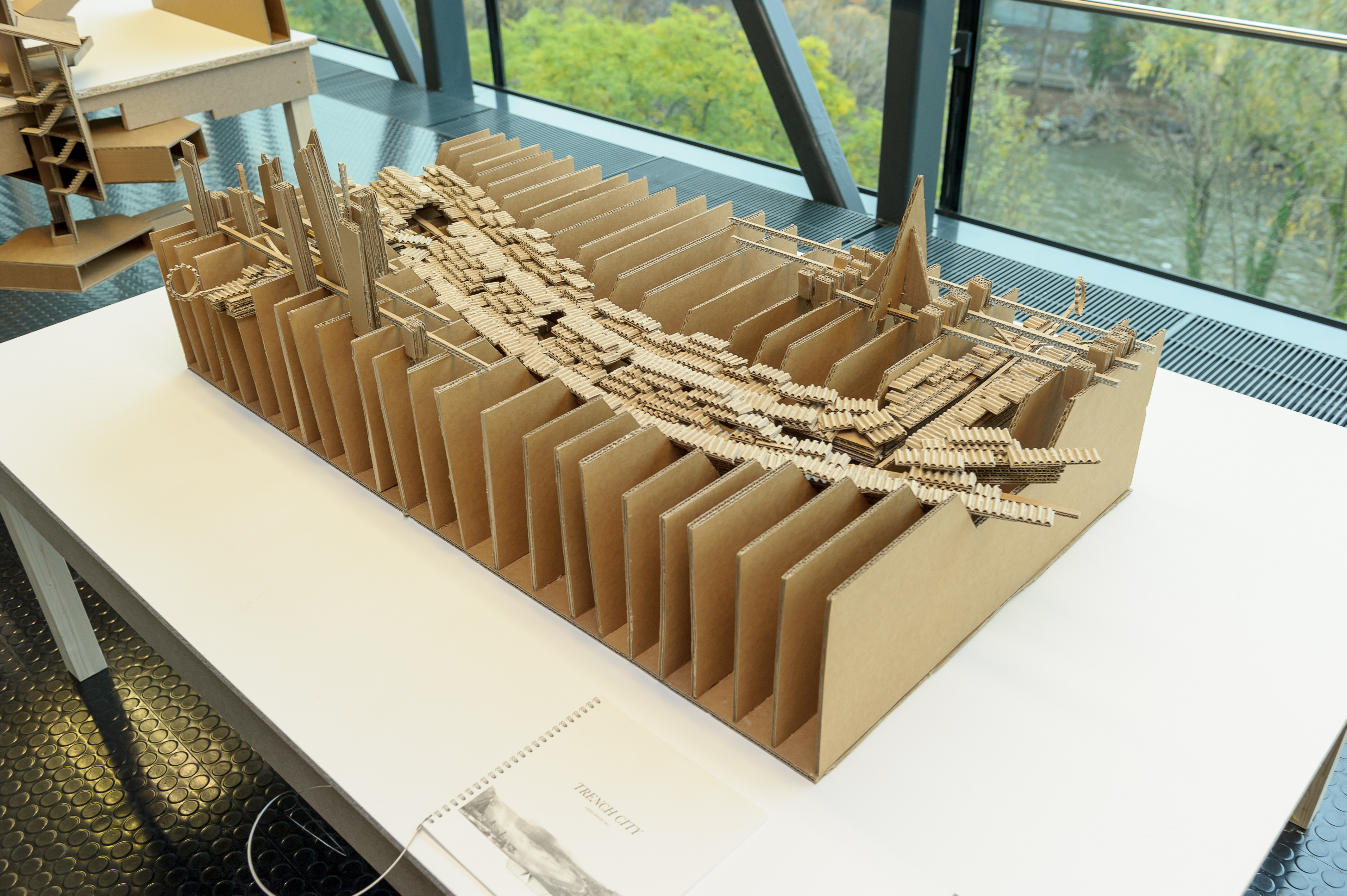
Maida Hodzic & Anna Johanna Grill: BRAG - Be Radically Green
It started innocently. With an article about the launch of the “BRAG: Be Radically Green City Project.” We didn’t pay attention, but reports kept coming in. Suddenly, the BRAG campaign went viral. A city attained world-wide fame for going green and we were standing on the sidelines. Naturally, we were questioning our options. If they did it, why shouldn’t we? And how did they do it? This leads us to my part: I was assigned the task to investigate the BRAG project, to reveal the formula of its success. I spent several months in the city, infiltrating and searching for the key of the campaign. The outcome was quite unexpected.

Gabriela Kammerhofer: Natuna Desa - Neuland am Meer
Jana Narapanganj, born in Bangladesh in 2014, studied physics and bionics in London. When she returned to Bangladesh in 2039 and found the country in a period of political and climate upheaval, she became involved in the development team of the Floating Shanties - informal floating cities. She moved from physics to social policy and is now one of the founding members of the first Floating Shanty Colony. In 2046, she founded the Technology Center for Maritime Water Research in the Bay of Bengal. In 2054, she received the Nobel Prize in Physics for the discovery of water-based energy transfer.
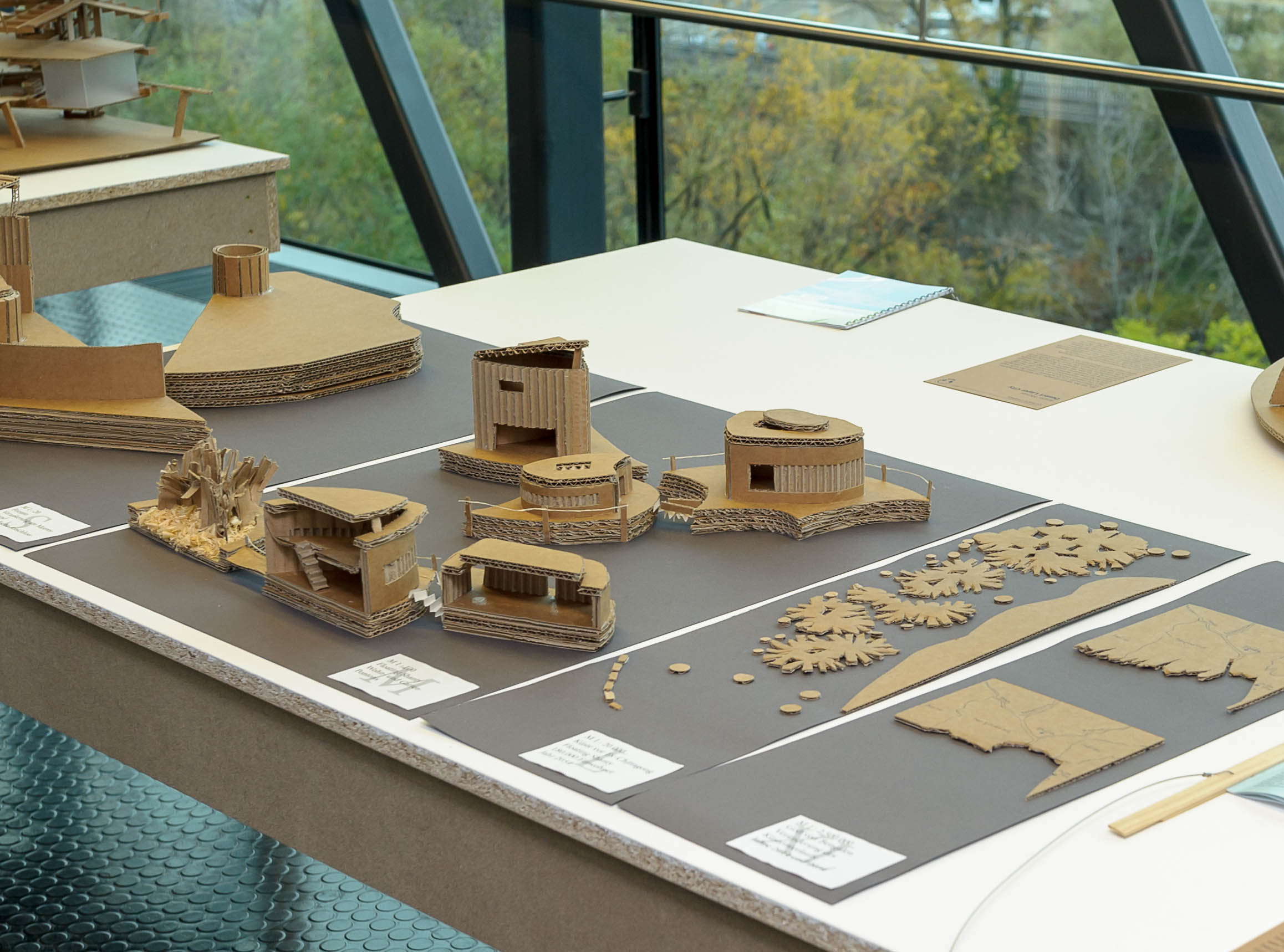
Alwin Moser: Desert Layer City
Welcome to Desert Layer City! As part of the Sahara Energy and Water Network, Desert Layer City is laid out in interconnected layers underground. The layers are connected by a system of pipes and shafts. Since the depletion of the world's oil reserves, the supra-regional importance of the Desert Cities lies in the production of energy for Europe. Heat from solar energy is used to keep simple Stirling engines running, generating power. The city thus not only covers its own energy needs but even produces a surplus for Europe in the process.

Emilian Hinteregger: PlastiCity
The plastic factory brings life back to a small town whose existence was once close to the abyss. Now the town is growing, and general prosperity with it. The plastic, which is provided by other towns in the form of garbage and processed into new plastic in the factory, is now the town's identity bearer. Plastic, the bringer of salvation, and its excessive consumption are becoming a dogma for PlastiCity. Be it in form, as well as content. Even the structure of the city resembles the molecular structure of plastic. Buildings, objects, plants, food, animals, people; everything is plasticized.
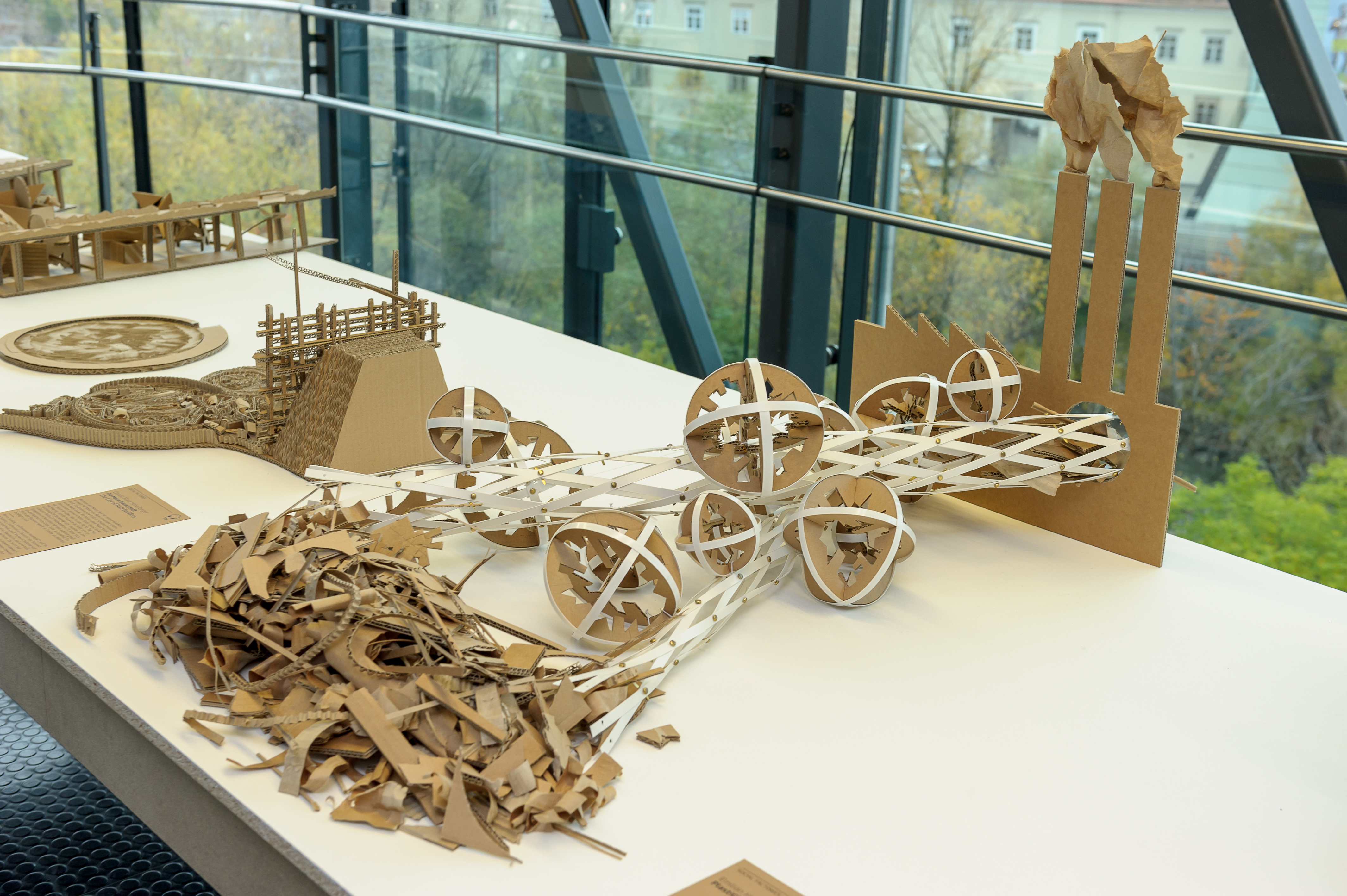
Maria Huber: Expressiva
Expressiva is the perfection of self-dramatization of a new social trend: the "metropolis of 5000 faces". The dwellings are carriers of the desired identities and transform the entire city into a magnificent theater of expression. From the spectator stands, 10-meter-high piers jutting out in all directions, one can witness the expressive transformations live. Every inhabitant is both protagonist and spectator. The city spreads radially around its center, the Factory of Expressions, and is divided into individual sectors. Each sector has a supply lock, which delivers food and energy upwards from the Impressiva below.

Claudia Maria Höhenberger: Die Mauerbauerstadt
We are building a wall, because we have to build a wall. We are building a wall around our beautiful city. To protect our beautiful city, we must build the wall. We have to build that wall, to protect our beautiful city. And so we build. Life by life, year by year, day by day. Like a ring, the wall wraps around the city, an impenetrable barrier to everything and everyone, 120 meters wide and 75 meters high at its strongest point. Generation after generation has laid stone upon stone to raise the wall high and ever higher. The duty of the individual gives way to the joy of being part of building the wall.

Catherine Papst: Die Verwandlung
The mobile border is an intermediate space, a space of transformation. Any immigrant who has the goal of coming to Europe can do so with the help of the mobile border. Its center is located in Brussels and is connected by underground tunnels to all bordering countries. This is where immigrants line up to take exams on their way to Europe. The further the immigrants move forward in the queue, the better their living conditions become. The tunnels end in an underground reception hall where escalators lead to the exit from the tunnel system.

Julian Gatterer: Hintergier
AUSTRIA LAUNCHES WELFARE PROJECT IN FAVOR OF POST-CAPITALISM. The first luxury chalets were occupied in Hintergier. Surrounded by the Tyrolean mountains, a new place has been created within two years with donations from Austrians showing solidarity. Planned by the Viennese team of architects "Generous Studios", profit-seeking people find a new home there. At the Hintergier Stock Exchange, speculative options can still be traded legally to increase account balances and prestige in the village. Supplied underground from the outside, the inhabitants of Hintergier are led to believe that they still rule the world...

Lukas Jakober: Degrowtopia
Welcome to Degrowtopia, surely the most relaxed and well-balanced city on the planet. Its inhabitants, the Degrowtopians, have all escaped the craziness of consumerist society. Degrowtopians believe in the power of reduction and the decrease of the amount of items around them which are not essential for them. Therefore they try to get rid of as much of their belongings as possible. They even decrease the space that is necessary for storing them, which on the big scale leads to more minimized and reduced housing units. Degrowtopians have even outsourced their kitchens, bathrooms, and living rooms to share them with others.

Jakob Zöbl: Social Layer Manhattan
In the middle of Manhattan lies a new, publicly accessible urban plain. Free of commercial use, it attempts to create a balance between above and below. The skyscrapers, which used to be symbols of a capitalist urban landscape, function here as pillars of a new, social layer. The Social Layer integrates all social strata and opens its gates to autonomy. Financed by a levy on financial and real estate speculation, fictitious money is invested in a real urban landscape that can be experienced by all people, in order to give back to the people what was once taken away from them by the powerful representatives of a radical ideology of growth.

Yan Ting Au: Footbridge City
In Hongkong, new footbridges form a continuous level of circulation. They are the extension and connection to the existing footbridges in the city. The new structures function as communication and connection platforms for both the physical and the mental dimension. People can be expressive and informative through the activity of walking. The free expression of thought becomes a natural behavior among the citizens, so that constructive ideas can be provoked and openly discussed. The citizens are encouraged by the footbridge system to be more concerned about the social issues around them.
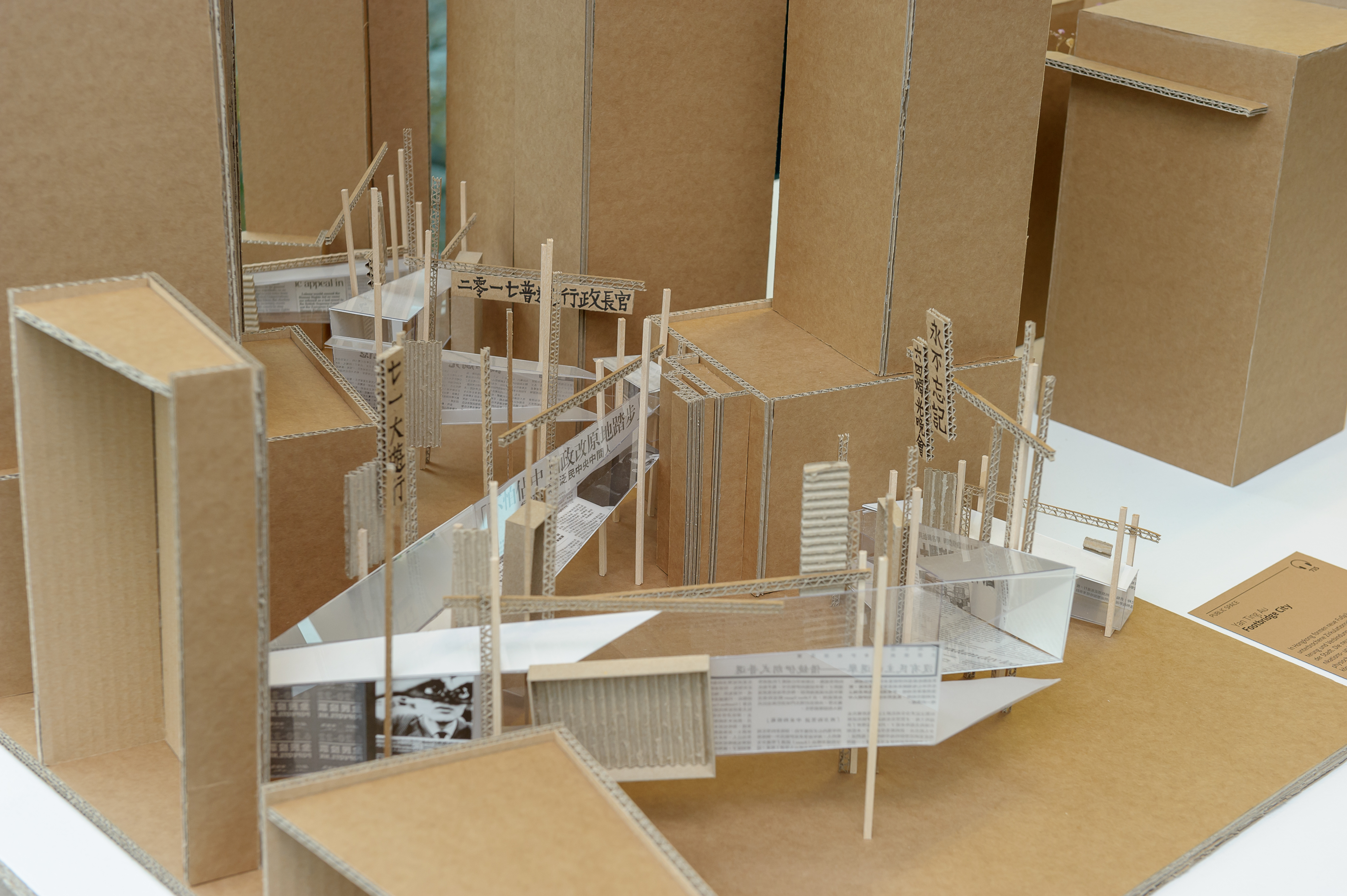
Josef Markus Tischler: Netzstruktur
Today you live in a quiet place and tomorrow you leave for a fast agglomeration characterized by constant movement, without having to plan this change of location for weeks or months. The network structure extends over the entire earth. Different networks within the structure offer space for living, working and relaxing at the same time. Spatial boundaries disappear, social relationships become more dynamic, and the concepts of independence and flexibility become the basis of a new philosophy of living.
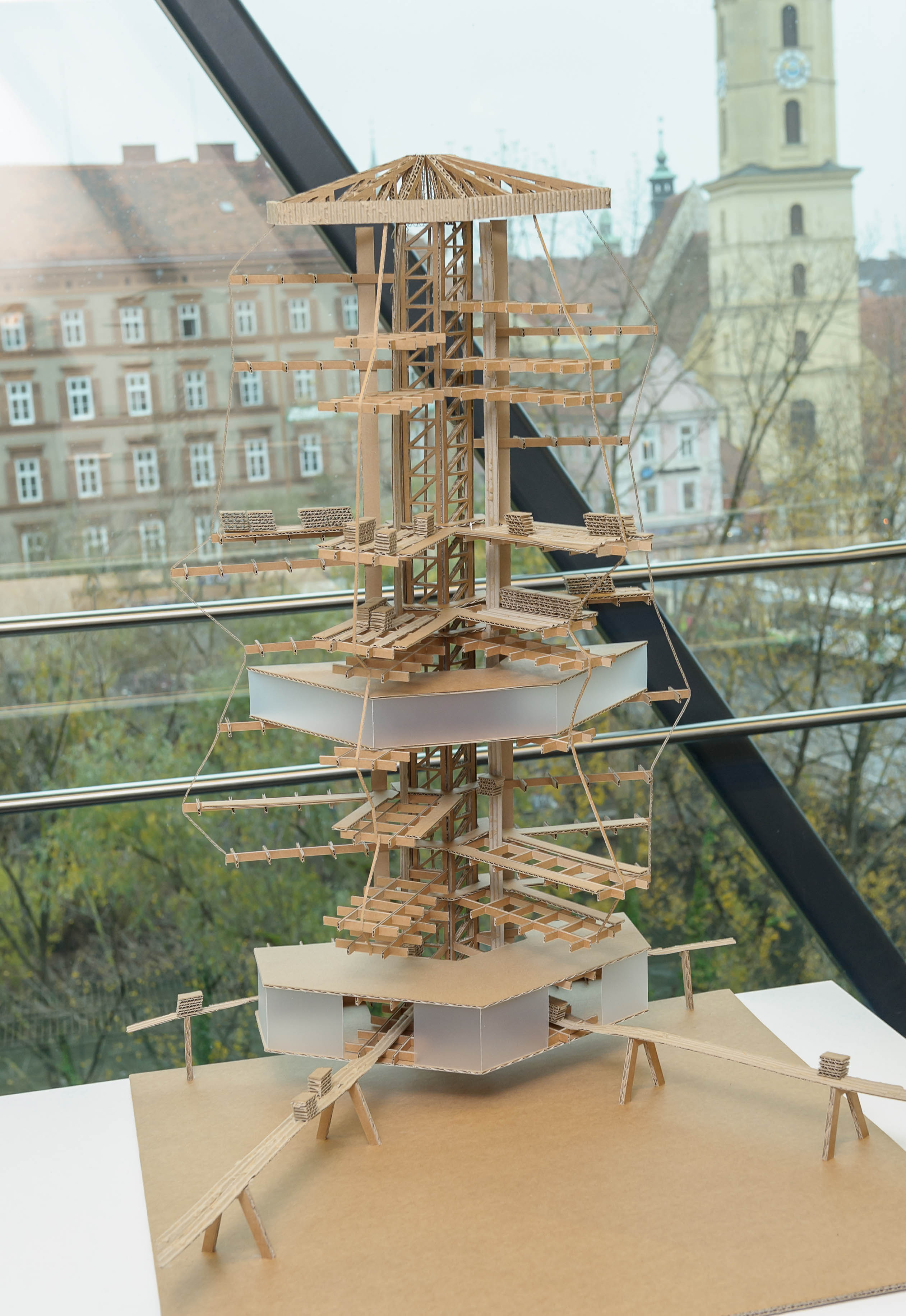
Martina Strauß: Vitaelevata
In the middle of a desert landscape lies Vitaelevata - a highly technologized, self-sustaining city. Each building is designed and constructed in the same way: Cylindrical vita towers form the basic structure of the city, where the daily life of the inhabitants takes place. The towers are surrounded by agricultural land that spirals around the structure. The fields and pastures are laid out according to the principles of vertical farming and form the backbone of Vitaelevata's food supply. Inside, people's dwellings adjoin the outer wall.
